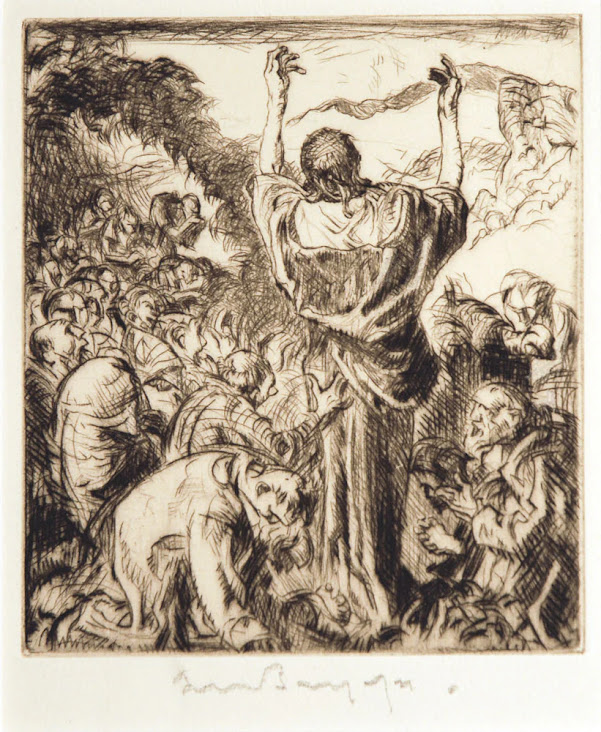Frank Brangwyn (b. Bruges, 13 May 1867: d. Ditchling, Sussex, 11 June 1956) was a British painter, printmaker, draughtsman, and designer, the son of a Welsh architect who specialised in church furnishings, and who was working in Belgium at the time of Frank’s birth. Between 1882–84 he served an apprenticeship with William Morris, and like his master he was active in a variety of fields. He was an Official War Artist during the First World War, and was considered one of the finest draughtsmen of the day; a skilful etcher and lithographer, who also made designs for a great range of objects (furniture, textiles, ceramics, glassware, and jewellery) however, he became best known for his murals. His most famous undertaking in this field was a series of large panels on the theme of the British empire, commissioned by the House of Lords.
All images © Estate of Sir Frank William Brangwyn.
This is part 7 of a 10-part series on the works of Frank Brangwyn:
 |
| 1928 North East Coast Industries colour lithograph poster for L.N.E.R. Railway |
 |
| c1927 Spanish Church lithograph on paper 18.3 x 15 cm |
 |
| 1927 Men looking at a procession lithograph on paper 31.5 x 41.5 cm |
 |
| 1930 The Forth-Bridge colour lithograph poster for L.N.E.R Railway 101.6 x 127 cm |
 |
| 1930 London Docks at Wapping or Rotherhithe Stations lithograph poster issued by the Underground Electric Railways Co. of London, Ltd 100.9 x 64.1 cm V&A Museum, London |
 |
| 1930 Brangwyn Ware lead-glazed earthenware teapot Doulton & Co., Lambeth Art Pottery, London |
 |
| 1930 Brangwyn Ware lead-glazed earthenware jug Doulton & Co., Lambeth Art Pottery, London |
 |
| 1930 Brangwyn Ware lead-glazed earthenware dish Doulton & Co., Lambeth Art Pottery, London |
 |
| 1930-35 The Book of Job There came a messenger unto Job etching on paper 5.5 x 10 cm |
 |
| 1930-35 The Book of Job And so they sat down with him upon the ground etching on paper 5 x 9.5 cm |
 |
| 1930-35 The Book of Job The ruin of his house etching on paper 7 x 10 cm |
 |
| c1930 Pollards Storefitters poster advertising the shop fitting firm E. Pollard & Co. colour lithograph 75 x 50.5 cm V&A Museum, London |
 |
| c1930 Pollards Storefitters poster advertising the shop fitting firm E. Pollard & Co. colour lithograph 75 x 50.5 cm V&A Museum, London |
 |
| c1930 Factory Interior with figures etching on paper 55 x 31.5 cm |
 |
| 1931 Jewish men in Belz, Paris etching on paper |
 |
| Title Page |
 |
 |
 |
 |
 |
 |
 |
 |
------------------------------------------------------ |
 |
| 1932 Bridge at Sospel etching on paper 17.8 x 15.2 cm |
 |
| c1932 Scotland By East Coast Route colour lithograph poster (size not given) |
 |
| 1933 Children at an Ice Cream Stall lithograph on paper 16.5 x 15.8 cm William Morris Gallery, London |
 |
| c1934 Jesus Carries His Cross lithograph on paper 76.2 x 81.3 cm |
 |
| c1934 A Study for 'Modern Commerce of the Port of Hull' oil on board 41.9 x 52.1 cm Dundee Art Galleries and Museums Collection |
 |
| 1934 Durham By LNER colour lithograph poster 50 x 70.1 cm |
 |
| 1934 9th Station of The Cross - Jesus falls for the third time woodcut on paper 42.5 x 46.5 cm |
 |
| c1935 Industrial scene (Chainmakers) pen and brown ink with pencil, charcoal and red chalk on thin wove paper 54.5 x 71 cm Royal Academy of Arts, London |
 |
| c1935 Agriculture blue and brown inks with red, blue and white chalks (or crayon?) over charcoal on wove paper 54.6 x 70.9 cm Royal Academy of Arts, London |
 |
| c1935 Study of the head of Christ on the Cross red and white chalk on blue wove paper 34 x 53.8 cm Royal Academy of Arts, London |
 |
| 1936 or before Two Bridges, Perugia (The Viaduct) oil on board 50 x 58.8 cm National Trust for Scotland, Brodie Castle, UK |
 |
| 1939 Two brothers killing one another watercolour & black ink on paper 25 x 18.5 cm |
 |
| 1939 or before The Slums of Venice oil on board 53.3 x 66.7 cm Dundee Art Galleries and Museums Collection (Dundee City Council) UK |
 |
| 1939 or before The Market Place, Hesdin oil on board 44.5 x 54.6 cm Dundee Art Galleries and Museums Collection (Dundee City Council) UK |
 |
| 1939 or before The Market Place, Algiers oil on canvas 63.5 x 76.2 cm Dundee Art Galleries and Museums Collection (Dundee City Council) UK |
 |
| 1939 Christ nailed to the Cross blue ink, watercolour, and charcoal (possibly also some chalks) on thin wove paper 49.7 x 66.1 cm Royal Academy of Arts, London |
 |
| 1945 Portrait of A. H. Mackmurdo red chalk on cream laid paper 50.3 x 65 cm Royal Academy of Arts, London |
 |
| 1946 A Procession, Genoa etching on paper 23 x 26 cm |
 |
| 1947 Design for 'The Wine Press' tapestry pencil and charcoal with coloured pastels on brown wrapping paper circa 56.6 x 67.6 cm Royal Academy of Arts, London |
 |
| 1947 The Wine Press oil on canvas 116 x 154 cm Dudley Museums Service, UK |
 |
| 1948 The Book of Job "And he offered burnt offerings" etching on paper 11 x 10 cm |


















































